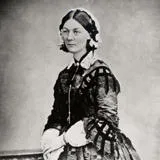
Florence Nightingale
Nurse and social reformer
Biography
Florence Nightingale (1820–1910) founded the world’s first professional school of nursing at St Thomas’ Hospital, the precursor to King’s Florence Nightingale Faculty of Nursing, Midwifery & Palliative Care.
Florence rose to prominence as a manager and trainer of nurses during the Crimean War. Known to the Victorian public as ‘The Lady with the Lamp’, Florence campaigned vociferously to improve conditions in the field hospitals, demanding better facilities and equipment as well as implementing accurate record keeping and drastically improving sanitation.
Upon her return to England, Florence sought to apply what she had learned to improve hospitals at home. She wrote widely on healthcare, sanitation and nursing practice and used funds donated by the public in gratitude for her work in the Crimea to establish a school of nursing at St Thomas’ Hospital in 1860. From the beginning, her aim was that ‘Nightingale nurses’ should go on to found training schools in Britain and throughout the world.
In 1883 Florence was the first recipient of the Royal Red Cross for exceptional services to military nursing. In 1904 she was appointed a Lady of Grace of the Order of St John (LGStJ) and she became the first woman ever to be awarded the Order of Merit (OM) in 1907.
Did you know? A keen mathematician, Florence pioneered the use of statistics in her campaigning and was an early proponent of the infographic. The Nightingale rose diagram (now known as the polar area diagram), which combines features of a pie chart and a histogram, was used by Florence to illustrate the causes of mortality in the field hospital she managed. In 1859, Nightingale was elected the first female member of the Royal Statistical Society.
